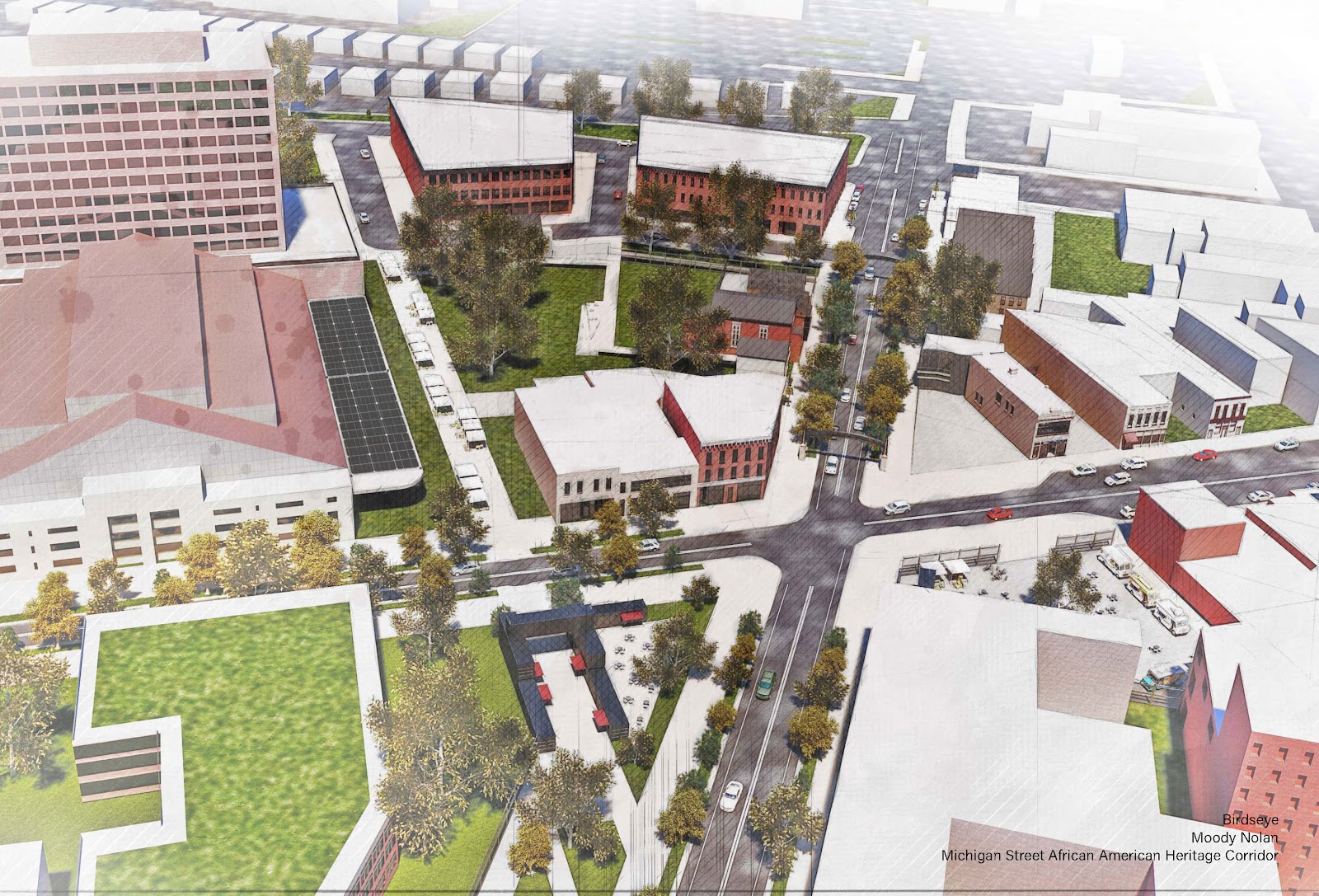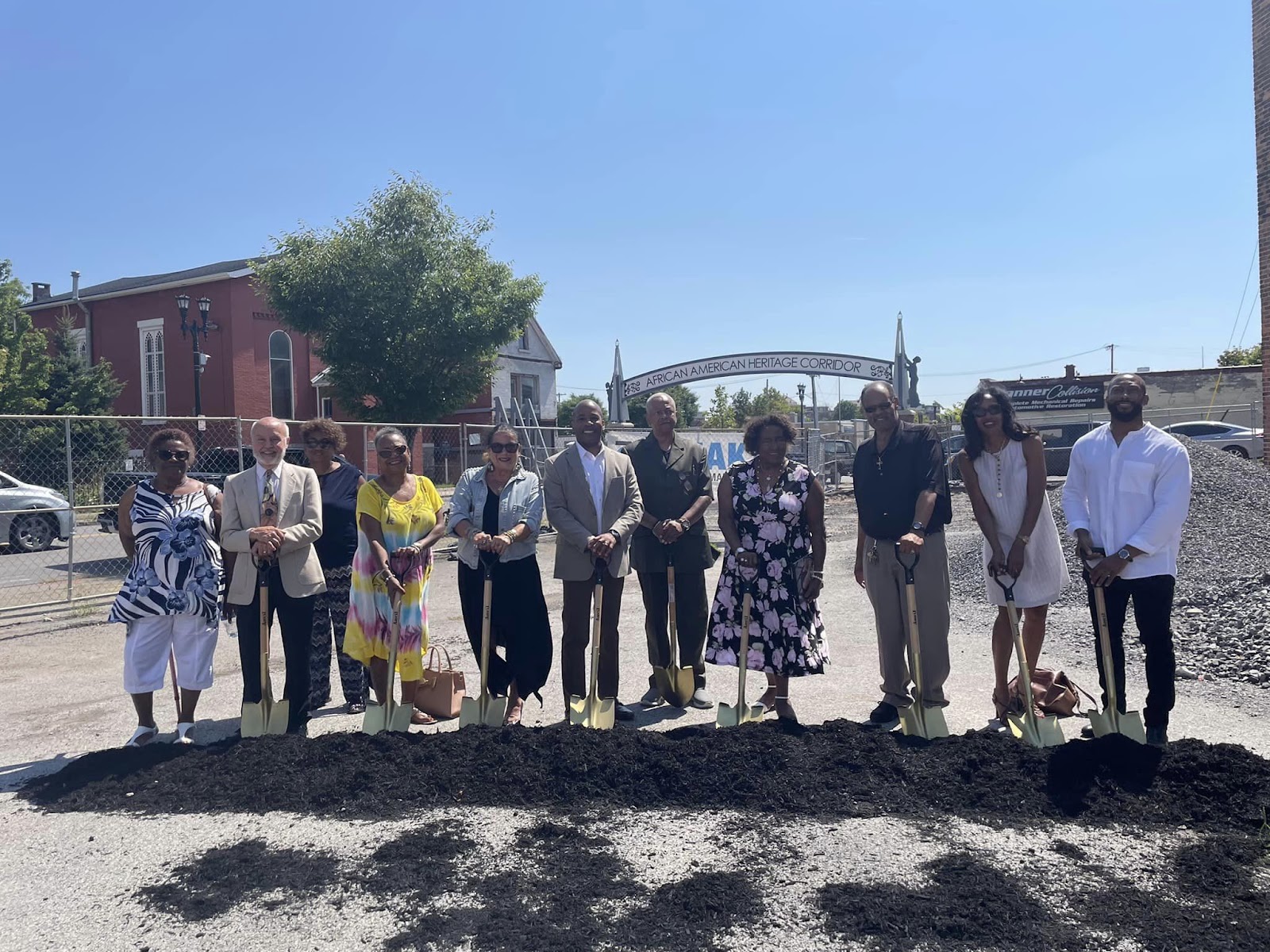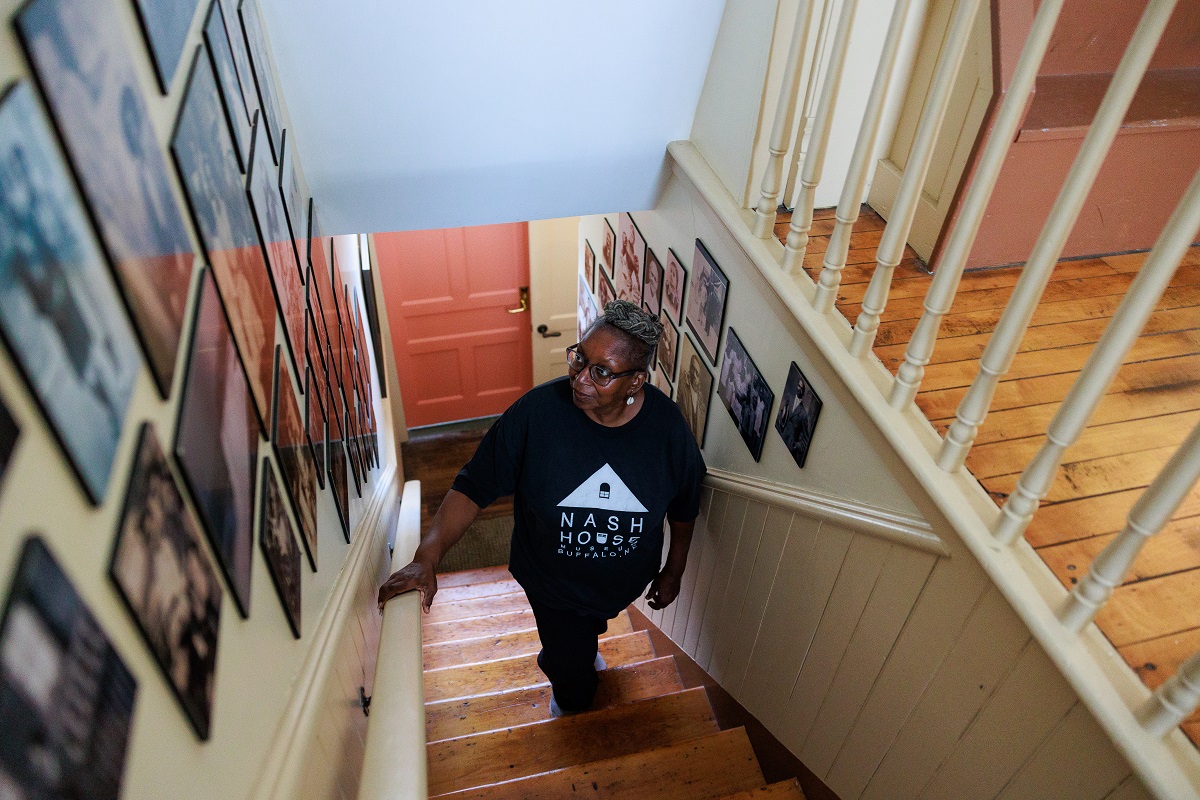 Birdseye rendering from the Michigan Street African American Heritage Corridor Strategic Action Plan, 2022
Birdseye rendering from the Michigan Street African American Heritage Corridor Strategic Action Plan, 2022
Buffalo’s Michigan Street played a unique role in local and national American history including the Underground Railroad and the Civil Rights Movement. It was home to many residents involved with the Niagara Movement –a precursor to the National Association for the Advancement of Colored Persons (NAACP) and the Colored Musician's Club that helped shape the Jazz Age.
In 2007, supported by leaders in the local African American community, the then NYS Assemblywoman (now Assembly Majority Leader) Crystal Peoples-Stokes sponsored state legislation to designate Michigan Street as a Heritage Corridor. The Corridor contains several key cultural and historic sites including the Michigan Street Baptist Church, the Nash House, the Colored Musician's Club, and the WUFO Black Radio History Collective. This legislation established the initial structure of the African American Heritage Corridor Commission (MSAAHCC) that includes representation from each of the heritage and cultural sites and other public and philanthropic organization stakeholders.
“This Corridor has been represented by so many different cultures,” said Terry Alford, Executive Director of the Michigan Street African American Heritage Corridor Commission. “Before African Americans started inhabiting it in the early 1920s, there were European immigrants like in many other urban cities across the country looking for new opportunities. This Corridor served a number of different peoples who had hope for themselves and their families and hope for new opportunities in this city.”
On January 1, 2021, the Commission became its own independent non-profit organization with a board that includes representatives from each of the four cultural anchor sites. “They will always have a seat at the table,” said Alford. “We want to make sure that our anchors are sustainable. It’s a covenant between the anchors and the Commission to always make sure that they have representation and a voice.”
Community Driven Strategy
In 2020, MSAAHCC hired Moody Nolan, an African American-owned design firm with a history of developing and promoting strategies that help transform communities and neighborhoods like Michigan Street, to lead the Strategic Action Plan.
“The intent of the Strategic Action plan was to facilitate a consensus-building planning process with stakeholders, including MSAAHCC Board and staff, elected officials, involved public agencies, key adjacent property owners, and the public,” said Alford. “It was to identify methods to best coordinate activities of each of these assets and formulate a concept design and spending and operating plan for the investment area to be financed with part of a pending NYS grant.”
The overall goal was to use this strategic plan to develop a uniformly agreed vision to tell the important stories of the Corridor, achieve sustainable operations for MSAAHCC, and continue to develop the Corridor to increase visitors and create future private investments.
“A fundamental part of the Commission’s mission and vision is to ensure that the Corridor is recognized locally as a focal point for learning about the city’s African American history and recognizing the Corridor’s heritage legacy nationally and internationally,” said Alford. “We want new residents to move into the area which will bring more spending dollars to the Corridor, new business leases, and create and support more local jobs. Michigan Street’s heritage tourism provides numerous benefits for the organization, community, and economic anchors.”
A Holistic Economic Development Strategy
As part of New York State’s overall effort to target revitalization in Western NY’s underserved neighborhoods, Empire State Development (ESD) committed $65M in state funding to revitalize Buffalo’s East Side through investments in nine target areas along Jefferson, Fillmore, Bailey, and Michigan Avenues.
MSAAHCC received $7M for capital improvements and to facilitate a coordinated tourism destination with four cultural anchor sites. To leverage public funding, private and philanthropic organizations, including the Ralph C. Wilson Jr. Foundation and the Community Foundation for Greater Buffalo, allocated an additional $8M through an “East Side Collaborative Fund” known as “East Side Avenues.” The Fund is managed by the University of Buffalo Regional Institute (UBRI) to support operations, programs, capacity building, and community infrastructure. ESD and the City of Buffalo partnered with UBRI to reach out to community members, to listen, analyze past investments, and create a comprehensive plan focused on what key stakeholders wanted to see happen and what projects they believed were important for promoting economic activity.
In 2019 and 2020, with the assistance of UBRI and East Side Avenues, the MSAAHCC grew stronger by formalizing its organizational infrastructure and administrative functions including a search for its first full-time executive director. “East Side Avenues helped organizations like ours that were asked to manage these funds but didn’t have the capacity to manage large-scale projects,” said Alford. “It created a mechanism to help with capacity and provide a support system that also found additional funding to assist with operational support like staffing and day-to-day administration. That’s where our staff salaries come from every year, but this funding stream is not infinite. The goal of this whole dynamic led by UBRI and East Side Avenues is to make sure that organizations like ours are up and running and self-sustainable within a set time frame, in our case five years, with the hope that in the fifth year we would be sustainable in finding our own funds.”
Concurrently, ESD is coordinating with the Church, Nash House, and the Colored Musician's Club to use a portion of the allotted $7M to address immediate capital needs to stabilize each property. “The next step will support sustainable operations, fundraising, and identify and prioritize how to use the remaining funding for future capital investments,” said Alford.
Most recently, Governor Kathy Hochul announced in August that the Colored Musicians Club began its $2.95M expansion and renovations to increase programming and tourism to the Corridor. The Colored Musician's Club was founded in 1918 and is the only remaining African American musicians club of its kind in the country. The Club hosted performances by notable artists including Duke Ellington, Ella Fitzgerald, Louis Armstrong, Nat “King” Cole, Miles Davis, and Cab Calloway.
 Inside the Colored Musicians Club with visitors inside of the Historic Colored Musicians Club & Jazz Museum.
Inside the Colored Musicians Club with visitors inside of the Historic Colored Musicians Club & Jazz Museum.
 Groundbreaking ceremony for the expansion of the Historic Colored Musicians Club & Jazz Museum.
Groundbreaking ceremony for the expansion of the Historic Colored Musicians Club & Jazz Museum.
Other improvements to the cultural anchors include:
$1.3 million for the Michigan Street Baptist Church to help ensure the building's structural integrity and address safety issues at the church, while also providing better access for disabled visitors. The project includes foundation repairs and roof reinforcement, plus accessibility renovations. The Michigan Street Baptist Church was built by African Americans in 1845 and was the last stop on the Underground Railroad for freedom seekers escaping through Buffalo to Canada before the Civil War. It's been listed on the National Register of Historic Places since 1974.
 Construction underway at the Michigan Street Baptist Church and 509 Michigan Ave, which will be the future home of WUFO Black Radio History Collective.
Construction underway at the Michigan Street Baptist Church and 509 Michigan Ave, which will be the future home of WUFO Black Radio History Collective.
$172,000 to the Nash House for weatherization improvements and upgrades to the museum exhibits. The Nash House was once the home of Reverend J. Edward Nash Sr., pastor of the Michigan Street Baptist Church through the 1950s and a renowned Buffalo civil rights leader. It is currently owned by the not-for-profit Michigan Street Preservation Corporation and has been operating as a museum since 2007.
 Sharon Holley, Chair of the Michigan Street Preservation Corporation, leads the Nash House Museum in the care and preservation of the historic house museum.
Sharon Holley, Chair of the Michigan Street Preservation Corporation, leads the Nash House Museum in the care and preservation of the historic house museum.
$1M to the WUFO Radio Station & Black History Collective for a significant restoration and expansion project. The Collective is the only African American owned radio station in Western New York and is the anchor tenant for 509 Michigan Street, a city-owned, one-hundred-year-old, two-story structure located south of the Michigan Street Baptist Church.
 WUFO Black Radio History Collective is led by Sheila Brown, owner of WUFO Radio Station. The radio station has been a staple of Buffalo's Black community for more than 60 years.
WUFO Black Radio History Collective is led by Sheila Brown, owner of WUFO Radio Station. The radio station has been a staple of Buffalo's Black community for more than 60 years.
These projects will create a tourist destination that will tell a unified story of Buffalo's contribution to African American history while attracting new visitors from the region and beyond.
Community Impact
The MSAAHCC Strategic Planning process involved extensive community engagement to articulate the community’s short-term and long-term goals. The following economic development opportunities reflect the Commission and the community’s goals and include:
-
Development of mixed-use buildings to bring more people to the Corridor (residential, commercial, museums, and cultural organizations).
-
Prioritize retail along the Corridor to strengthen the visitor experience and increase revenue.
-
Support new cultural uses and long-term public spaces along the Corridor to enhance the local community and tourism.
“We’re trying to promote and encourage more people to live in this Corridor,” said Alford. “We’re looking at using this part of the Corridor as the economic engine, focusing on heritage tourism with the hope that it will spur community development…not just in this part of the Corridor with our four cultural anchors, but to serve as an economic engine to develop the entire 3.5 miles of the Corridor.”
Alford also wants to make sure that alongside these developments there are affordable housing options for those who live and work within the Corridor. “Investors are using this opportunity to look at building both affordable and not-so-affordable housing. It’s exciting to see certain development happening but obviously what we all fear is gentrification or more marginalization. When we say Buffalo’s East Side, it’s two-thirds of the city. Most of the people who live in these communities are not middle class or higher, they’re moderate or lower economically. It’s a historically marginalized community, and not just for African Americans but for a lot of different folks who find themselves living here and for generations have been ignored.”
One of the main goals for MSAAHCC was to keep the community included in the development of programs and services for the Corridor.
“What makes us so proud of this plan was that it was definitely consensus building,” said Alford. “Over the course of the pandemic, all of these community engagements were a little more challenging because we had to do them virtually but the community that we reached to help make this plan came from different walks of life and different areas of the Corridor representing elders, faith-based communities, educators, young professionals, and civic and social organizations.”
Visitor and Local Experience
“We’re unique, unlike the other three Corridors where they work with just one board of directors, Audrey [Clark] and I work with five boards –the Commission board and each anchor site board.”
MSAAHCC Program Manager Audrey Clark coordinates with each board to schedule regular meetings, working with each anchor site to market the Corridor as a collective entity and incorporating ways of sharing multiple historical stories through a contemporary lens.
“It’s still a work in progress but basically we’ve spent more than two years making everybody a cohesive unit,” said Clark. “Each cultural site was operating on its own with its own limited hours if they were open at all. Our goal was to get them to operate together with similar open hours, and ticket prices, and share all their resources like tour guide training. We wanted to create a cohesive experience between each historic site. You’re not just hearing the story of the Church or the Nash House, but a continuation of the story of the neighborhood, making it a much fuller experience when you visit the Corridor. It’s about building the programs for both the neighborhood and bringing in outside visitors.”
One example is “Mrs. Frances Nash’s Garden Basket,” a program that launched in June in partnership with the African Heritage Food Co-Op, Buffalo Go Green, and the East Side Garden Walk to distribute Community Support Agriculture (CSA) farm shares. From June through October the program distributed 30 free CSA farm shares every week on a first-come, first-served basis. This program is named after Frances Nash, the wife of Rev. J. Edward Nash, who was interested in nutrition and was a lifelong advocate for healthy eating. “She had a wonderful community garden that she used to provide produce to her neighbors in the 1940s until it was demolished by the city since she did not own the lot it was growing on,” said Clark.
The program helps mitigate challenges created by a lack of affordable healthy food in the Michigan Street Corridor and MSAAHCC is working on a long-term solution for providing healthy food options to residents of the East Side.
“The idea is that next year we’re going to expand to have a farmer’s market in the Corridor focusing on having affordable produce options,” said Clark. “It’s programs like this one where it’s not strictly history based or even bringing in other large flashy economic development projects but rather a small-scale grassroots kind of project that makes it more meaningful for residents.”
Vision for the Future
“I was born and raised in these communities that are connected to the Corridor, primarily in the Historic Fruit Belt. I remember from the time I could walk the vibrant communities right along Michigan Street. There was a massive amount of housing and businesses like corner stores, hairdressers, barbers, and all types of bars with live music. Most notably I remember the gardens and tree-lined avenues. Michigan Street used to have a canopy of trees that adorned the entire avenue.” Alford also remembers Urban Renewal which transformed the Corridor. “That’s when NYS Route 33 was built right down the middle of the African American community and knocked down homes and businesses with the promise of new, which never happened. It was a site to see and to have the opportunity to live through that. Hopefully, we can plant the seeds and grow it back again.”
The next step is purchasing a commercial property for the MSAAHCC office, serving as a visitor center hub for the cultural anchors. Alford said that they hope to close on a property before the end of the year. “We’re ready to take this project on and hire more staff to help the Commission and provide support to the anchors.”
MSAAHCC will implement strategies centered on business growth for the Corridor that support the strategic plan including business incubator partnerships and business technical assistance. “We’re immediately looking to provide funding that we received from Senator Schumer to provide economic development for each of the anchors,” said Alford.
In March 2022, Senator Schumer secured $800,000 as part of the bipartisan omnibus spending package. $500,000 of these funds will go to the Buffalo Niagara Freedom Station Coalition for renovating and revitalizing the Michigan Street Baptist Church, one of the cultural anchors of the MSAAHCC. $300,000 went to MSAAHCC to develop a strategic plan to bolster investment, entrepreneurship, redevelopment, and job creation along the Corridor.
“It’s my hope that each anchor will have its own economic development and business plans. In the short term, the Commission is working with the city to improve street designs and curb appeal including wayfinding, and art installations. “We're looking for short-term wins, immediate wins. We need to show that we’re doing things that complement our programming that Audrey is leading and the capital projects that our anchors are involved with.” Alford is focused on keeping the momentum going.
“I can’t wait for people to see us two years from now to see how far we’ve advanced and progressed in this part of the Corridor,” said Alford. “I believe that while yes this is the African American Heritage Corridor but like how it was in the early 20th century we’re going to have a multicultural group of people living here side by side, working, playing, and praising together. I think we’re already seeing it.”
Learn more about the Michigan Street African American Heritage Corridor Commission: https://www.michiganstreetbuffalo.org/
